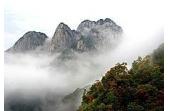Bank Of China Tower
- Things to do
-
- Photo(10)
- Tips&article(100)
- Make it Happen
- Map
-
loading...
- Other Tours
-
- Tsing Ma Bridge
- Kat Hing Wai
- Repulse Bay
- Discovery Bay
- Hong Kong
- Victoria Harbor
- Tai O
- Aberdeen
- Man Mo Temple
- Kowloon Masjid And Islamic Centre
- Zoological And Botanical Garden
- Happy Valley Racecourse
- Ocean Park
- Wong Tai Sin Temple
- Victoria Peak
- Kowloon Walled City Park
- Disneyland Park
- Convention And Exhibition Centre
- Avenue Of Stars
- Lantau Island
Feature
- One of Hong Kong’s most striking skyscrapers.
- Designed by the famous architect IM Pei.
- Like a crystal in the sky.
- Currently ranked No. 17 in the world in terms of height.
Overview
The building was completed in 1990, and it was once the tallest building in the world outside of the United States. Before that, the tallest skyscrapers were all in the US. It is more than 300 meters tall -- more than 1,000 feet. It was designed by the famous architect named IM Pei who was born not far away in the nearby city of Guangzhou and educated in the United States. It is reminiscent of the Willis Tower that was formerly called the Sears Tower in Chicago that was the tallest building in the world for a long time. But the Willis Tower is composed of rectangular blocks and has rectangles in its framework, and Bank of China Tower is composed of triangular sections with triangular frames and is reminiscent of crystalline growth and structure. The glass facets of the building reflect the light and the surroundings, so it is like a bright and shiny white crystal, while the Sear Tower appears dark and brooding.
The sharp corners and bright, reflective features caused a lot of
controversy when it was being built. The Chinese have a belief
system called “Feng Shui” that dictates architectural style. IM Pei
was aware of Feng Shui principles. His wife was a Chinese woman who
studied landscape architecture. In Feng Shui, a mirror brings the
energy of the Feng Shui water element that represents wealth.
Mirrors are used to expand space; to draw the beneficial Chi
energy, wealth, and health in; and to reflect bad, evil energy.
Imagine the controversy that was caused when the biggest building
in Asia went up and it reflected, redirected and soaked up the
geomantic energy in the whole city of Hong Kong! Sharp angles, the
building is full of sharp angles, represents an attack on the
places pointed at, and people in Hong Kong comment and joke about
which institutions and buildings are the major targets.
The cross braces and triangular framework of the building are
designed to withstand typhoons. The structure is said to mimic
bamboo. However, the building looks nothing like a bamboo stalk.
Because of the strong framework of the building, comparatively less
steel was needed for the building’s construction.
The Sightseeing Terrace on the 43rd floor is open to the public, and it is a good place to see the city of Hong Kong. Hong Kong has about the most very tall skyscrapers of any city in the world, and it is said to be among the world’s most architecturally beautiful cities. Almost every evening when the weather is not stormy, the Bank of China Building along with most of the other big buildings around Hong Kong Bay take part in a sound and light display, and the buildings are lit up with computer controlled lighting effects in concert with music and narration.
History
The building is historic because it was the first building taller than 300 meters or 1,000 feet that was built outside of the United States. It can be said to be the forerunner of the current tall skyscraper boom around the world. It was an achievement of architect IM Pei that has received many architecture and design awards. In a way, Pei’s coming to Hong Kong was like coming home since he was born in the nearby city of Guangzhou. The Japanese company Kumagai Gumi built it. The building was officially inaugurated in 1990.
Touring Activities
- Admiring the design and considering the meaning of the Feng Shui.
- See the rest of the city of Hong Kong from the public viewing platform on the 43 floor.
- Hong Kong has four of the twenty tallest buildings in the world all in a small area around the bay. Appreciate modern skyscraper design.
Travel Essentials
1) Location: No. 1 Garden Road in Central District on Hong Kong Island. Central
is Hong Kong’s main business and government district.
2) How to go there: Next to the Central MTR Station.
3) Open Times: Monday to Saturday. It is closed Sundays.
4) Fee: No fee. Open to the public.
Nearby Attractions
Central District is interesting for seeing architecture because there are ultra-modern buildings near Victorian-era colonial buildings and old Chinese architecture – all within walking distance. You can see the old British architecture at Hong Kong Park and at St. John’s Cathedral. Traditional Chinese architecture is at the Man Mo Temple. There are also unusually good and free public park areas and zoos at Hong Kong Park and the Zoological and Botanical Gardens, and two good museums that are just a ferry ride across the bay at the Space Museum and the Hong Kong Museum of Art.
To see the fine free sound and light show called the Symphony of Lights that utilizes the tall buildings around the bay, you can watch and listen to the music and narration at the Avenue of Stars that is a pedestrian area along the bay that is also a highlight in itself.
Related Reading
About Chinese Architecture.
It is outside the Exit J2 at Central Station.How to Get to there?
Tips & articles
|
|
|
forum discussion
|
|
|











